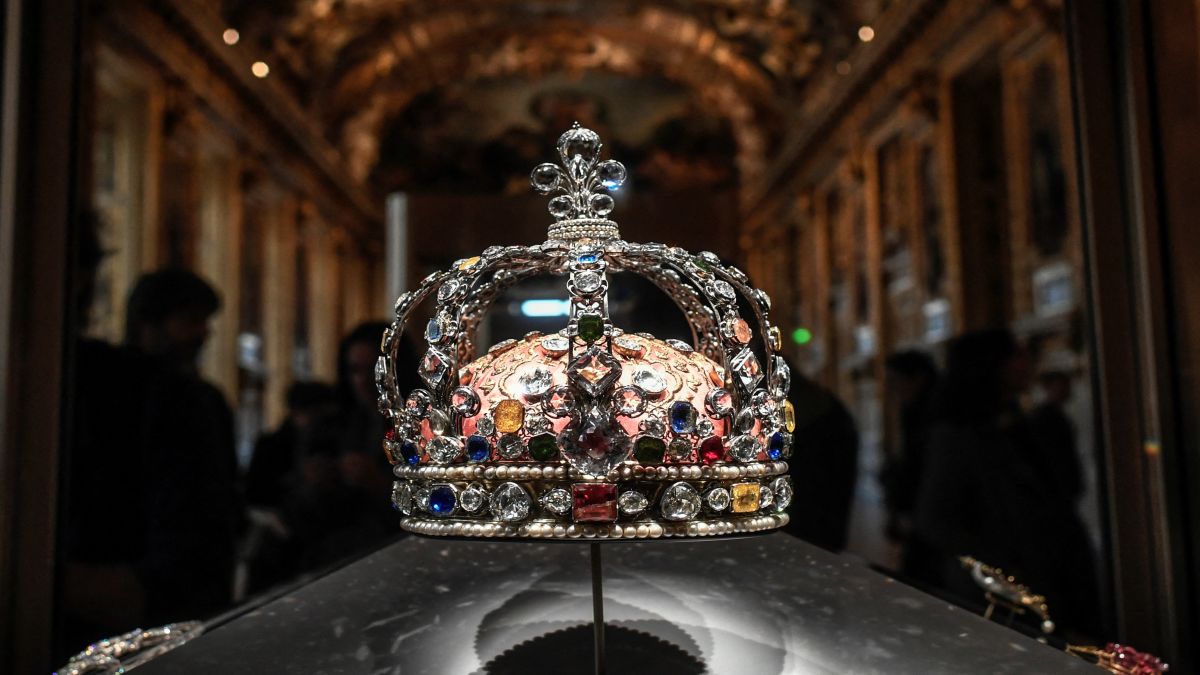It’s been over three days since a gang of four thieves carried out what is being called an audacious heist at Paris’ Louvre Museum and decamped on scooters with eight of France’s ‘invaluable’ crown jewels.
Investigators are still on the hunt for the thieves and the stolen jewels, which have now been valued at more than $100 million. “The Louvre curator estimated the damages to be €88 million euros, or $102 million,” Paris prosecutor Laure Beccuau said Tuesday. But she said the greater loss was to France’s historical heritage, adding that the thieves would not pocket the full windfall if they had “the very bad idea of melting down these jewels”.
What is interesting about the heist is that the thieves left behind one very notable diamond worth an estimated $60 million. More interesting is that the diamond has an Indian connection.
We explain it all below.
The Louvre loot
On Sunday (October 19), a gang of four thieves brazenly broke into the Louvre Museum in the French capital and within eight minutes pilfered away eight “objects of inestimable heritage value”. The thieves then escaped on scooters, marking it as, perhaps, the most brazen and audacious heist at the museum.
The jewels stolen by the thieves included diadems (a jewelled headband), necklaces, earrings and brooches. All are from the 19th century, and once belonged to French royalty or imperial rulers.
According to the French cultural ministry, the stolen jewels were:
>> A pearl diadem of Empress Eugénie: This exquisite pearl and diamond diadem belonged to Empress Eugenie, wife of Napoleon III. The headpiece includes 212 pearls and 1,998 diamonds and was acquired by the Louvre in 1992.
> Diamond bodice bow: Another belonging of Empress Eugenie, this large bow-shaped adornment was created as part of a belt intended to be shown at the Universal Exhibition in Paris in 1855 and then worn by the empress afterward. The empress later had the grandiose piece reworked to become a bodice brooch.
>> Emerald necklace and a pair of emerald earrings: The thieves took the two surviving pieces from an emerald and diamond jewellery set that Napoleon had gifted his second wife, Marie-Louise, upon their marriage in 1810. The original set included a tiara, a necklace, a pair of earrings, and a comb, but the necklace and earrings were the only pieces that survived in their original state into the 21st century.
>> Parts of a sapphire set: The burglars also took three pieces — a tiara, necklace and earring — from a sapphire and diamond set worn by Marie-Amélie de Bourbon, the queen of Louis-Philippe, king of France (1830–48), and by Hortense, queen of Holland, stepdaughter of Napoleon I, and mother of Napoleon III.
>> The reliquary brooch: The chandelier-like diamond brooch, which once also belonged to Eugénie, who was a pious Roman Catholic, was also stolen in the heist.
Regent diamond untouched and its India connection
Very surprisingly, the thieves left the Regent diamond, which was also on display at the Louvre, untouched. This incredible 140.6-carat gem sat untouched in its case with Paris prosecutor Laure Beccuau telling Reuters, “I don’t have an explanation. It’ll only be when they’re in custody and face investigators that we’ll know what type of order they had and why they didn’t target that window.”
For the uninitiated, the massive diamond emerged from the Golconda region in India, more specifically, the Kollur mine in Andhra Pradesh. Legend has it that a slave found it in the mines and hid it in a leg wound. In its raw form, the Regent Diamond was believed to be 410 carats.
The slave then set off for Madras (modern-day Chennai), hoping to sell the stolen diamond in one of India’s bustling secondary markets. However, his dreams of freedom quickly turned into a nightmare. The worker made the fatal mistake of trusting an English sea captain to ferry him to safety by making a deal with him and offering him 50 per cent of all profits on the diamond sale. The captain, driven by greed, forcibly took the diamond from the worker and tossed the poor man overboard in a cruel twist of fate.
The diamond eventually made its way to England and was cut down into several smaller stones, one of which was sold to Philippe II, who was named regent of Louis XV (hence the Regent Diamond name). The diamond went on to be set in crowns for the coronations of Louis XV and Louis XVI. The diamond even adorned a hat worn by Marie Antoinette.
As per a report in naturaldiamonds.com, by 1791, the Regent Diamond’s value had soared more than four times its original purchase price, making it the most valuable and symbolic jewel in France, a testament to the grandeur of French royalty.
After the French Revolution, the Regent Diamond made its way to Napoleon Bonaparte, who used it on his sword.
The ‘curse’ of the Regent Diamond
However, many believe that the Regent Diamond seems to carry tragedy wherever it goes — aka it’s cursed.
For instance, the slave who first found the gem and tried to escape with it met a disastrous end when the greedy English captain killed him. Similarly, King Louis XVI and Marie Antoinette, who were in possession of the Regent Diamond, were executed during the French Revolution.
Also, Napoleon Bonaparte was exiled from France twice, left to die on his own on an island.
And it seems that the thieves, who struck the Louvre Museum, may have known of the diamond’s history and hence, steered clear of it.
Other Indian diamonds at the Louvre
Sunday’s heist at the Louvre Museum has also shone a spotlight on the presence of Indian diamonds being a part of France’s most culturally important artefacts.
For instance, apart from the Regent Diamond, the Louvre also hosts the Hortensia Diamond as well as the Sancy Diamond. The Hortensia, with its pink hue, originated from India’s Golconda Region. The history of this gem remains murky until today, but it first appeared in the French crown jewels in the reign of King Louis XIV. Notably, the Hortensia also remained untouched during the Louvre heist.
Another Indian diamond that remained safe was the Sancy Diamond — a pear-shaped 55.2-carat gem. Discovered in Golconda too, it has exchanged hands several times before it landed up being sold to Louis XIV.
Unfortunately, not all Indian diamonds were safe during the Louvre heist. According to a report by The Juggernaut, some of the diamonds in the emerald set that was stolen possessed gems from India. Moreover, the reliquary brooch, which was stolen, has diamonds from the Mazarin collection, which is also believed to have an Indian connection.
With inputs from agencies


)

)
)
)
)
)
)
)
)



